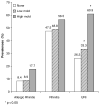Environmental risk factors of rhinitis in early infancy
- PMID: 16771781
- PMCID: PMC2233943
- DOI: 10.1111/j.1399-3038.2006.00386.x
Environmental risk factors of rhinitis in early infancy
Abstract
Previous studies of allergic rhinitis in children have not documented the environmental risk factors for infants at age one. We examined the relationship of environmental tobacco smoke (ETS) and visible mold exposures on the development of allergic rhinitis, rhinitis and upper respiratory infection (URI) in a birth cohort where at least one parent was skin prick test (SPT) positive. ETS exposure and upper respiratory symptoms were obtained by questionnaires. Visible mold was classified as none, low or high during home visit. Infants had a SPT at age one. After adjustment for potential confounders, exposure to >20 cigarettes per day was associated with an increased risk of developing allergic rhinitis at age one [odds ratio (OR)=2.7; 95% CI 1.04-6.8] and rhinitis symptoms during the first year (OR=1.9; 95% CI 1.1-3.2). Infants with low (OR=1.5; 95% CI 1.1-2.3) or high (OR=5.1; 95% CI 2.2-12.1) levels of visible mold in their homes were more likely to have more frequent URI during the first year. Older siblings were protective for development of both rhinitis symptoms and allergic rhinitis. This study suggests that ETS exposure, rather than visible mold, is associated with rhinitis and allergic rhinitis in infants. The analysis also suggests that mold may be a stronger risk factor for URI that ETS.
Figures
References
-
- Blackwell DL, Tonthat L. Summary health statistics for U.S. children: National Health Interview Survey, 1999. Vital Health Stat. 2003;10:1–50. - PubMed
-
- Mercer MJ, van der Linde GP, Joubert G. Rhinitis (allergic and nonallergic) in an atopic pediatric referral population in the grasslands of inland South Africa. Ann Allergy Asthma Immunol. 2002;89:503–12. - PubMed
-
- Cost-effective treatment of rhinitis: A managed care perspective. The health and economic impact of rhinitis. Am J Manag Care. 1997;3:58.
-
- Fokkens WJ, Scadding GK. Perennial rhinitis in the under 4s: a difficult problem to treat safely and effectively? A comparison of intranasal fluticasone propionate and ketotifen in the treatment of 2–4-yr-old children with perennial rhinitis. Pediatr Allergy Immunol. 2004;15:261–6. - PubMed
Publication types
MeSH terms
Substances
Grants and funding
LinkOut - more resources
Full Text Sources



